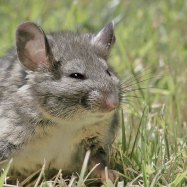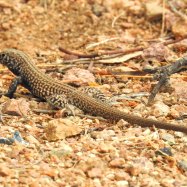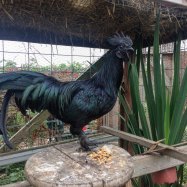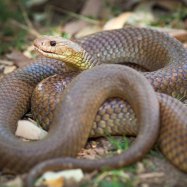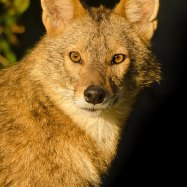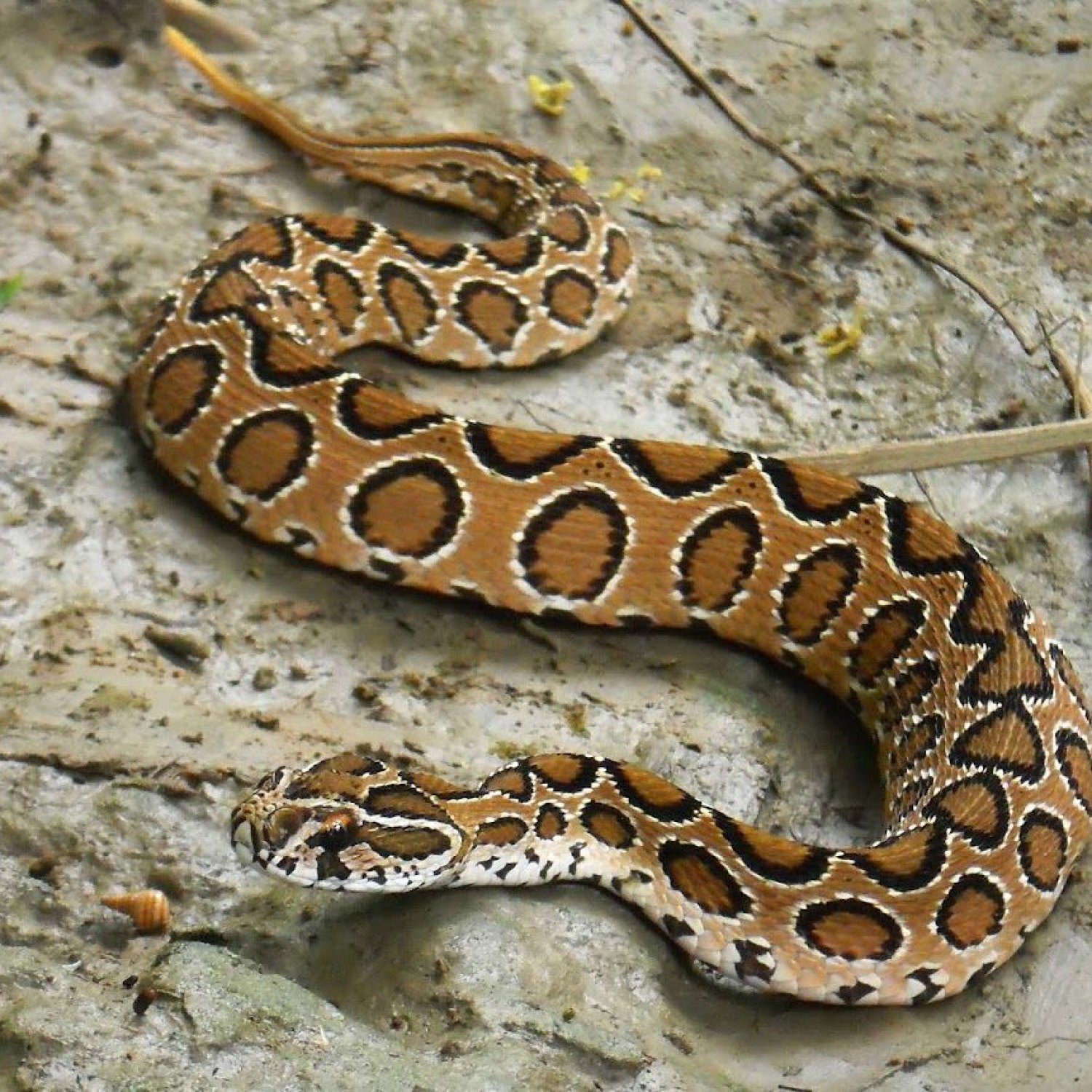
Russels Viper
Up to 5 feet
The Russels Viper, also known as the Chain Viper, is a venomous snake found in South Asia. It can grow up to 5 feet long and belongs to the Viperidae family. Its distinctive feature is its cylindrical and stout body shape, making it a dangerous predator to be aware of in its natural habitat. #RusselsViper #SouthAsia #VenomousSnakes
Animal Details Summary:
Common Name: Russels Viper
Kingdom: Animalia
Habitat: Grasslands, forests, agricultural areas
The Secretive Venomous Snake: Russels Viper
Hidden in the grasslands, forests, and agricultural areas of South Asia, the Russels Viper, scientifically known as Daboia russelii, is a name that strikes fear in the hearts of many. With its pale brown or gray body and venomous bite, this snake is not to be trifled with. In this article, we will explore the incredible world of the Russels Viper, from its physical characteristics to its geographic distribution, and why it is a fascinating animal that deserves our attention.The Classification of Russels Viper
Before diving into the intriguing features of this reptile, it is essential to understand its taxonomy Russels Viper. The Russels Viper belongs to the kingdom Animalia, which encompasses all animals. It falls under the phylum Chordata, which includes animals with spinal cords. As a reptile, it is a part of the class Reptilia, along with snakes, lizards, and crocodiles. Within the order Squamata, the Russels Viper belongs to the family Viperidae, where it is joined by other venomous snakes such as rattlesnakes and adders.The Physical Appearance of Russels Viper
The Russels Viper has a distinctive appearance that sets it apart from other viper species. Its body is cylindrical and stout, with an average length of up to five feet. However, some specimens have been known to reach up to six feet in length. Its coloration, consisting of pale brown or gray with dark brown or black patches, provides perfect camouflage in its natural habitat.One of the most notable features of the Russels Viper is its triangular-shaped head, which is wider than its neck Rhino Beetle. This shape allows for potential prey to be easily swallowed whole. The viper also has a pair of heat-sensing pits located on its head, which help it detect and locate warm-blooded animals.
The Secret Weapon: Venom
As a carnivorous animal, the Russels Viper feeds mainly on rodents, lizards, birds, and other small animals. But what sets this viper apart from other predators is its venom. The snake possesses potent hemotoxic venom, which directly attacks the blood and tissues of its prey. The venom also has anti-clotting properties, making it difficult for animals to stop bleeding and increase the chances of internal bleeding.The Russels Viper has a unique way of delivering its venom through its fangs. The fangs are hollow, allowing the venom to travel from the glands located behind the eyes and into the prey with each bite. While the venom is deadly to potential prey, it is also dangerous to humans. In fact, the Russels Viper is responsible for the most snakebite deaths in the Indian subcontinent.
The Geographic Distribution of Russels Viper
The Russels Viper is native to India, Pakistan, Sri Lanka, and Bangladesh. In India alone, it can be found in almost all states except for the northeastern regions. The snake is widespread, inhabiting a variety of environments, including grasslands, forests, and even farmlands.One interesting fact about this viper is that it is a solitary and secretive snake, often hiding in crevices or burrows during the day and coming out at night to hunt. Due to its elusive nature, many encounters with humans occur when people accidentally step on them, leading to a defensive bite.
Unique Features and Threats to Survival
Apart from its venom, the Russels Viper has additional unique features that are worth mentioning. One such feature is its ability to reproduce through parthenogenesis, a form of asexual reproduction. This allows the snake to produce offspring without mating, making it self-sufficient in certain circumstances.Like many other animals, the Russels Viper also faces threats to its survival. The biggest threat is habitat loss due to human activities such as deforestation and agricultural expansion. In addition, the illegal trade of this snake for its venom and skin is also a significant threat. The practice of snake charming, a form of entertainment in some Asian countries, also poses a danger to the species as the snakes are often mistreated and their fangs removed for safety.
In Conclusion
The Russels Viper, with its mysterious and deadly nature, is an extraordinary animal that deserves our attention. Its unique characteristics, such as its venom and ability to reproduce through parthenogenesis, make it a fascinating subject for study. However, the threats to its survival are also a cause for concern. As with any animal, it is crucial that we preserve their habitats and protect them from harm. So, next time you come across a Russels Viper, remember to appreciate it from a safe distance, as it is an essential part of the ecosystem that we must protect.

Russels Viper
Animal Details Russels Viper - Scientific Name: Daboia russelii
- Category: Animals R
- Scientific Name: Daboia russelii
- Common Name: Russels Viper
- Kingdom: Animalia
- Phylum: Chordata
- Class: Reptilia
- Order: Squamata
- Family: Viperidae
- Habitat: Grasslands, forests, agricultural areas
- Feeding Method: Carnivorous
- Geographical Distribution: India, Pakistan, Sri Lanka, Bangladesh
- Country of Origin: India
- Location: South Asia
- Animal Coloration: Pale brown or gray with dark brown or black patches
- Body Shape: Cylindrical and stout
- Length: Up to 5 feet
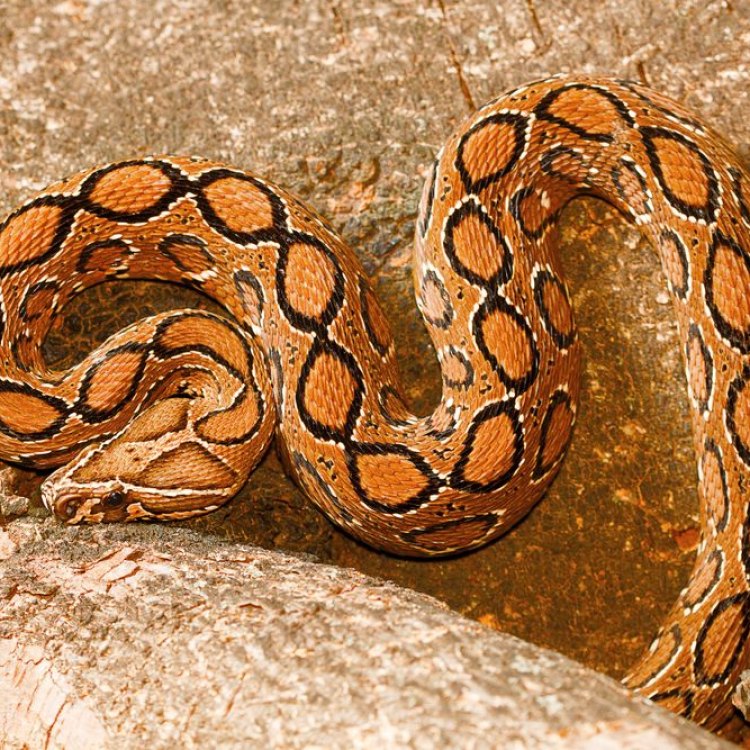
Russels Viper
- Adult Size: 2-4 feet
- Average Lifespan: 10-20 years
- Reproduction: Sexual
- Reproductive Behavior: Mating occurs during spring and summer
- Sound or Call: Produces a hissing sound when threatened
- Migration Pattern: Non-migratory
- Social Groups: Solitary
- Behavior: Nocturnal
- Threats: Habitat loss, poaching
- Conservation Status: Vulnerable
- Impact on Ecosystem: Maintains balance in prey populations
- Human Use: Anti-venom production
- Distinctive Features: Triangular head, venomous fangs
- Interesting Facts: Responsible for the most snakebite-related deaths in India
- Predator: Birds of prey, mongoose, other snakes
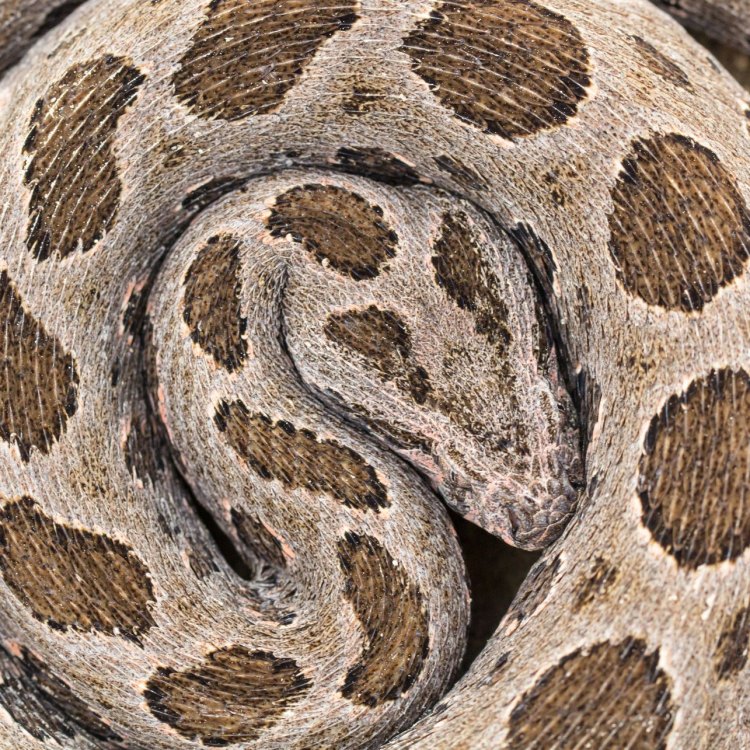
Daboia russelii
The Enigmatic Russels Viper: A Fearless Predator with a Vital Role in Ecosystem
Among the many species of snakes that slither through the wilds of Asia, the Russels Viper is one of the most intriguing and feared. With its striking appearance and potent venom, this snake has earned a reputation as a dangerous predator. However, beyond its notorious reputation, the Russels Viper plays a vital role in maintaining the delicate balance of its ecosystem.Found in India, Pakistan, Southeast Asia, Indonesia, and parts of China, the Russels Viper (Daboia russelii) belongs to the family Viperidae PeaceOfAnimals.Com. It is also known as the chain viper, or simply as Russel's Viper, named after famous Scottish herpetologist Patrick Russel who first described the species.
The Russels Viper is a medium-sized snake, with adults ranging from 2-4 feet in length. However, some specimens have been recorded reaching up to 6 feet. They have a robust, muscular body with a distinct, triangular-shaped head. This unique feature, along with their venomous fangs, allows them to easily catch and incapacitate their prey.
The lifespan of the Russels Viper is relatively long, living up to 10-20 years in the wild. However, the exact lifespan in captivity is still unknown.
Like most snakes, the Russels Viper is a sexual reproducer. Mating in these vipers occurs during the spring and summer months when the temperature is warmer Red Diamondback Rattlesnake. The female viper will lay a clutch of 20-30 eggs, which hatch after an incubation period of about 3 months. The young vipers are fully independent upon hatching and do not receive any parental care from their mother.
One of the most distinctive features of the Russels Viper is its hissing sound. When threatened or disturbed, they will produce a loud hiss, warning other animals to stay away. This sound is created by the rapid movement of air through their nostrils.
Unlike some snake species that exhibit migration patterns, the Russels Viper is non-migratory. They prefer to stay in a specific range and are territorial animals. Their habitat of choice includes forests, grasslands, and even human settlements, as long as there is enough cover for them to hide and hunt.
With their solitary nature and nocturnal behavior, Russels Vipers are rarely seen during the day. They are most active at night, hunting for prey such as rodents, lizards, small birds, and even other snakes. Their venom is highly potent and can kill their prey quickly, making them one of the top hunters in their ecosystem.
Despite their fierce reputation, Russels Vipers are a crucial part of their ecosystem. As top predators, they play a crucial role in maintaining a balanced equilibrium in prey populations. Without their presence, the ecosystem would become imbalanced, leading to an increase in the population of smaller animals, which could cause a ripple effect on other species.
Sadly, the Russels Viper's population is under threat due to various human activities, leading to their classification as a vulnerable species by the International Union for Conservation of Nature (IUCN). Habitat loss, caused by rapid urbanization and deforestation, is the primary threat to these vipers. As forests are cleared for human settlement and agricultural purposes, their natural habitat shrinks, leaving them with less space to thrive.
Adding to these threats is the illegal poaching and trade of Russels Vipers for their venom. Their venom contains several toxins that are used in making anti-venom for snakebites, a major health concern in South and Southeast Asia. Despite being protected by law, the illegal hunting and trade of this species continue, further endangering their population. Conservation efforts, such as creating protected areas and educating local communities about the importance of these vipers, are crucial to their survival.
Apart from their role in balancing ecosystems and the illegal animal trade, Russels Vipers have played a significant role in medical advancements. The venom of these vipers is currently being used to produce anti-venom for snakebites. With India alone reporting around 70,000 snakebite deaths every year, this anti-venom is a life-saving medication for many. Research is also being conducted to explore the venom's potential in treating various human diseases, such as cancer and blood clots.
The most distinctive feature of Russels Vipers, their venomous fangs, can inject large amounts of potent venom into their prey, causing severe damage and even death. The venom contains several toxins that target various body functions, leading to tissue damage, blood clots, and paralysis. Interestingly, Russels Vipers are responsible for the most snakebite-related deaths in India, making them the deadliest snake species in the country.
Although the Russels Viper has a fearsome reputation, they also have their fair share of predators in the wild. Birds of prey, including eagles and hawks, are known to hunt these vipers. Smaller predators, such as mongooses, also feed on these snakes. In some cases, other snakes, such as cobras and kraits, have been seen hunting and consuming Russels Vipers.
In conclusion, the Russels Viper is an enigmatic snake species that plays a crucial role in its ecosystem. Beyond their fearsome reputation, they have several distinctive features and interesting behaviors that make them a unique species. Sadly, their population is under threat from various human activities, highlighting the importance of conservation efforts. As we strive to protect this species, it is crucial to remember their vital role in the delicate balance of nature and their contributions to modern medicine.
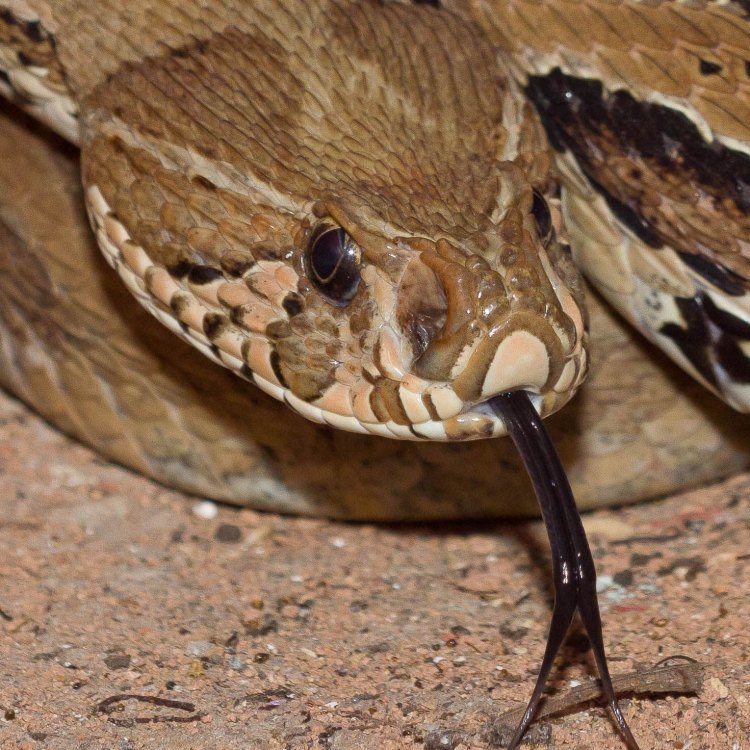
The Secretive Venomous Snake: Russels Viper
Disclaimer: The content provided is for informational purposes only. We cannot guarantee the accuracy of the information on this page 100%. All information provided here may change without prior notice.

